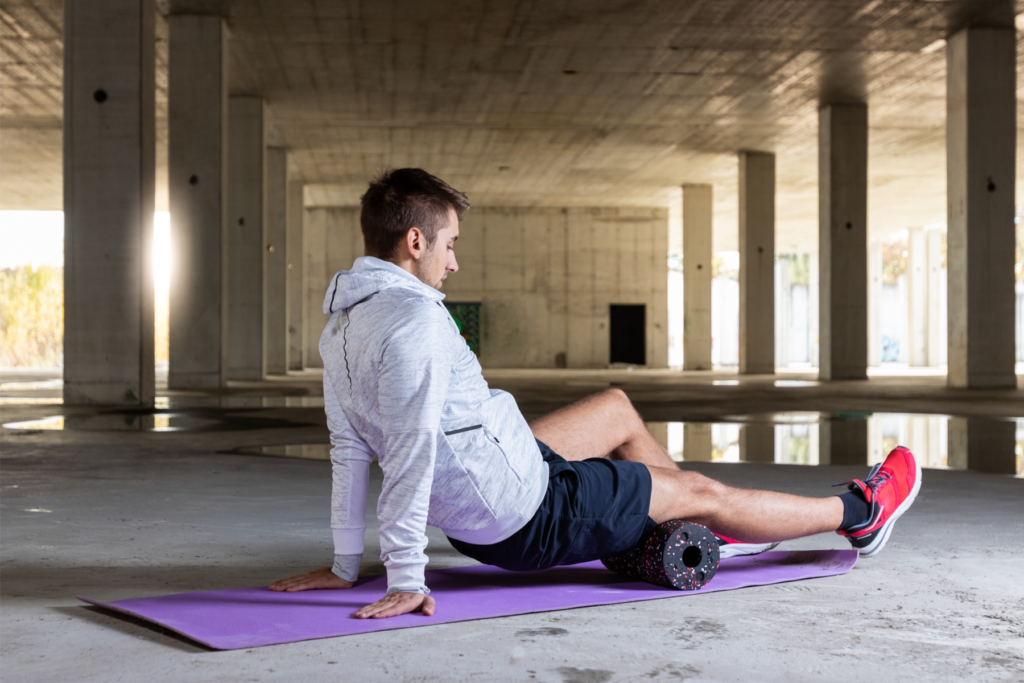
When I was a full-time personal trainer, I had been lifting consistently for about 2 years and was in the gym from 7am to 7pm either with clients or prospecting them. Needless to say, I was working out during my downtime which meant a lot of frequent exercise. Then one day, it happened. I stepped up to the platform to do my deadlifts. Just a warm-up of only about 40 pounds. No big deal, I had deadlifted hundreds of pounds before. However, I had only completed 4 reps when I had to drop the bar due to being in unbearable pain. I had pulled muscles in my back that prevented me from being able to twist either way or bend over. I was so confused as to how I could have injured myself so badly from lifting only a fraction of the maximum amount of weight I was strong enough to lift. The answer was that I had never foam rolled a day in my life and what happened to me was inevitable as a result. If you lift weights (especially if you lift weights and experienced unexplained back pain), then you want to read this article.
What is Foam Rolling Exactly?
Foam rolling, or SMR in trainer’s terms, has a mechanism that’s too complex to explain at length in this article. And to be honest, the science isn’t all the way there for us to know exactly what foam rolling does. But for now, let me put what we know in simple terms. Do you know that very thin layer of tissue that covers your chicken breast? That’s called fascia…and it covers every single one of your own muscle fibers. In a perfectly functioning body, when your muscles move, these fascia slide by each other with ease.
However, whenever your muscles get “tight” due to consistently heavy lifting (typically with bad form), injury, poor posture, inactivity or even sickness, these fascia start to stick to each other forming adhesions or “knots.” These knots cause that “tightness” you feel sometimes before or during a workout when you feel stiff and inflexible. If it’s bad enough, you can even feel it when doing daily activities, but likely have no idea what the cause is. Sometimes though, and this is important, you can’t feel tightness at all and only find out your body is riddled with knots when you get blindsided by an injury — this is exactly what happened to me. It doesn’t always happen whenever you’re pushing the limits and squatting 300 pounds like most people think. On the contrary, because tight muscles are like ticking time bombs, it likely happens most often when you’re just warming up or even just bending over to pick up your cat.
Whenever you foam roll, that intense pain you feel is the foam roll putting pressure on one of those knots. If you hold this pressure long enough, receptors in your muscles tell the fibers to relax. It’s then theorized that the relaxation of your trigger point allows the muscles to stretch out, loosen those painful knots and realign your muscle.
The 3 Benefits of Foam Rolling
The benefits are not entirely known, but what the consensus is amongst fitness professionals (and what I’ve seen with athletes) are the following benefits should be enough to make you a believer:
1.) It Helps Prevent Injury
This is a simple one. All of my D1 athletes roll before every workout and the in-season athletes will take 1-2 full days off from lifting just to spend the hour of lifting time foam rolling and stretching. This is because athletic strength coaches understand the stress regular weightlifting puts on the body, how strongly it can tighten the muscles to harmful levels and the importance of devoting time to muscular health. When muscles are allowed to become tight, like a rubber band that’s been stretched and pulled tighter, and tighter, and tighter day after day for weeks, all it takes is the smallest amount of force for it to snap. The last thing you need is to embarrass yourself by dropping your fully-loaded deadlift bar in the middle of a crowded gym because you didn’t take the time to roll beforehand.
2.) It Can Improve Posture and Alleviate Mysterious Pain
Ever find yourself hunched over with your shoulders rounded and head forward without even realizing how awful your posture is? This is called Upper Crossed Syndrome and it’s super common amongst people who work an office job or play a lot of video games. If either of these is you, you can probably think of some pain you’ve had in your neck or back. Try to pay attention to how your upper body is positioned next time you’re at your desk. You might be surprised at how easy it is to default to this without realizing it. This forward posture causes tightness in your chest and upper back/lower neck. When you can use a ball to loosen these areas and strengthen the muscles that weakened due to the tightness, you can improve your posture and possibly alleviate pain. Do you have unknown lower back pain? It’s almost definitely tightness in your hips or elsewhere in your lower body and rolling these areas can sometimes provide immediate relief.
3.) It Can Help You Lift More with Less Effort
In a 2018 study, 16 male weightlifters performed two sets of workouts: One where they did no foam rolling and another where they foam rolled for 3 days straight. The subjects reported that, the week they did consistent foam rolling, they were able to lift more weight with less perceived effort than the week they did not foam roll. This is likely because, when your muscles are less tight, they are able to activate and contract more effectively to generate more force. In short, foam rolling makes you stronger.
The bottom line? Foam rolling has a host of benefits and, if you truly care about taking care of your body, you should include it in your fitness routine. And, even if you don’t work out and are sedentary, you might benefit even more from regular foam rolling. Now keep in mind: rolling these areas won’t loosen them overnight (after all, they didn’t tighten overnight), but rolling daily can definitely help with pain and posture over time. As a final note, foam rolling is not appropriate for everyone, if you have heart failure, kidney problems, low bone density, a blood disorder or a skin condition, you shouldn’t foam roll. If you have any other medical condition, definitely check with your doctor before you start any sort of SMR.





